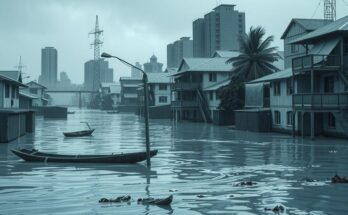Cyclone Chido struck Mayotte on December 14, 2024, with devastating winds of 225 kilometers per hour. Formed on December 5, the cyclone was the most powerful to affect Mayotte in over 90 years, causing extensive damage in key areas. Following its impact on Mayotte, Chido continued to Mozambique, maintaining its status as a Category 4 tropical cyclone throughout its path.
On December 14, 2024, Cyclone Chido devastated the islands of Mayotte, as high-velocity winds wrought havoc across the French territory. The cyclone, which formed on December 5, rapidly escalated before striking the Mauritian islands, ultimately reaching peak sustained winds of approximately 250 kilometers (155 miles) per hour. Upon making landfall in Mayotte, Chido registered sustained winds of 225 kilometers (140 miles) per hour, marking it as the most powerful storm to impact the region in over nine decades. According to satellite assessments from the European Union and reports from Météo-France, extensive damage occurred within key areas, notably the capital city, Mamoudzou, and the Pamandzi airport. Following its passage over Mayotte, the cyclone continued westward and impacted Mozambique on December 15, maintaining its status as a Category 4 tropical cyclone throughout its trajectory.
Cyclone Chido emerged in the southeastern Indian Ocean and underwent rapid intensification prior to its impact on the Agaléga Islands on December 11, 2024. Favorable atmospheric conditions, including elevated sea surface temperatures and low wind shear, contributed to its strength. The cyclone’s trajectory took it just north of Madagascar before making landfall on Mayotte, where it caused unprecedented damage. With the storm’s intensity recorded at sustained winds of 225 kilometers per hour, the consequences of Chido are unprecedented in recent history for this French territory in the Indian Ocean, underscoring the pressing realities of climate phenomena.
In conclusion, Cyclone Chido has left a substantial mark on Mayotte, highlighting the increasing vulnerability of island communities to severe weather phenomena. The cyclone’s rapid intensification and destructive landfall reveal significant challenges posed by climate change and necessitate imperative discussions on disaster preparedness and resilience. As recovery efforts unfold, the region must address structural vulnerabilities to mitigate future impacts from such catastrophic events.
Original Source: www.earthobservatory.nasa.gov




